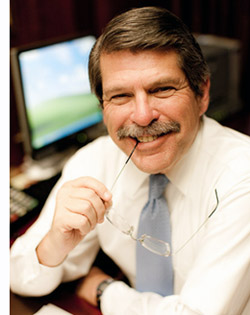L.A.’s big green secret
December 7, 2009
 Something remarkable is unfolding in the mountains above our urban sprawl — something for the ages. Parcel by parcel, acre by acre, we have amassed more protected open space than any major metropolis in the nation.
Something remarkable is unfolding in the mountains above our urban sprawl — something for the ages. Parcel by parcel, acre by acre, we have amassed more protected open space than any major metropolis in the nation.
Government sometimes deservedly gets a good knocking for its failures, for too often letting intergovernmental rivalries derail the best of intentions. But every so often, it’s important to take stock of successes that can temper the cynicism and restore a sense of civic idealism.
The story of the Santa Monica Mountains is one of those, one that has been told only in bits and pieces spread across the years. It’s a textbook example of collaboration between federal, state and local officials who worked hand-in-hand with grassroots groups dedicated to protecting the area from the kind of development that overtook the Hollywood Hills.
For me, the preservation of the Santa Monica Mountains is both political and personal.
As a young boy growing up in Boyle Heights on the Eastside, my family would pack us up for weekend picnics in Griffith Park. I’d hike, play football and experience wilderness just minutes from the grit and congestion of my neighborhood. In the park, it seemed I could breathe easier.
I carried those memories into elective office. As a member of the Board of Supervisors, the Santa Monica Mountains were in my district. It was now my responsibility to build on the legacy of my predecessor, Ed Edelman, who with former Rep. Anthony Beilenson and the late LA City Councilman Marvin Braude, championed the preservation of open space.
Over the decades, we have pursued two tacks.
One is to restrict the scope of development. Yes, property owners do have the right to build but they do not have the right, for example, to shave off gorgeous ridgelines to maximize panoramic views from their mansions. In other words, the terrain must dictate the development, not the opposite, despite the arguments of high-priced lobbyists and lawyers for developers.
The second approach has been to acquire parcels from willing property owners largely with funds approved for this purpose by voters. To that end, in 1997 we created a matrix we called “The Big Picture,” which identified parcels ripe for protection based on whether they contained ridgelines, creeks or wildlife corridors. Then we made a beeline for them.
I’m proud to report here that almost every high-priority property on our list has now been taken off the table, purchased by a consortium of county, federal and state agencies, including the Santa Monica Mountains Conservancy.
No property better exemplifies what we’ve been able to accomplish than the $34 million acquisition of King Gillette Ranch, off Mulholland Highway near Malibu Canyon. At one point, the spectacular 600 acre property was on its way to becoming the stomping grounds of 5,000 students as part of a proposed expansion of Soka University.
In a private meeting that never made it into the headlines, I’ll never forget the extraordinary scene of representatives from federal, state and county government sitting around a table pledging millions of dollars so we could hit the purchase price. The magnitude of our task dwarfed our individual affiliations. We were of one mind.
Now plans are underway to transform King Gillette Ranch into a gateway for the Santa Monica Mountains recreation area, complete with a visitors’ center for those who’ll be enjoying the mountains long after we’re gone. Still, our work is not done. Next year, a state water bond issue is slated to come before you with funding set aside for more acquisitions. You know how I’m voting.
All of this, of course, is about more than a hike in the park. The protection of open space has become an environmental imperative in reducing the impact of air pollution and global warming. The Santa Monica Mountains have been called “the lungs of LA,” consuming carbon dioxide and cleaning the air. In fact, one of California’s strategies in meeting global warming mandates is to preserve natural land.
Now, let’s head back to Griffith Park.
For more than a decade in the late 1800s, the Los Angeles City Council balked at accepting Colonel Griffith’s generous but seemingly odd donation of rugged land on the far outskirts of the city. Year after year, the local officials asked why in the world they would want responsibility for it. What good was it anyway?
Thankfully, we know the answer to that. Griffith Park is a crown jewel of our urban life, surrounded, but not enveloped, by buildings and freeways. The park was there for me as a youngster, as it was for my children and, perhaps some day, for theirs, too. Today, we’ve helped ensure that, no matter what development awaits the region, the Santa Monica Mountains will be unscathed and unscarred.
And that’s something remarkable.












 405 bridge work causes a stink
405 bridge work causes a stink





